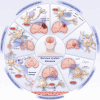Mitochondrial quality control and transfer communication in neurological disorders and neuroinflammation
- PMID: 40356918
- PMCID: PMC12066325
- DOI: 10.3389/fimmu.2025.1542369
Mitochondrial quality control and transfer communication in neurological disorders and neuroinflammation
Abstract
Mitochondria, as the primary energy factories of cells, play a pivotal role in maintaining nervous system function and regulating inflammatory responses. The balance of mitochondrial quality control is critical for neuronal health, and disruptions in this balance are often implicated in the pathogenesis of various neurological disorders. Mitochondrial dysfunction not only exacerbates energy deficits but also triggers neuroinflammation through the release of damage-associated molecular patterns (DAMPs), such as mitochondrial DNA (mtDNA) and reactive oxygen species (ROS). This review examines the mechanisms and recent advancements in mitochondrial quality control in neurological diseases, focusing on processes such as mitochondrial fusion and fission, mitophagy, biogenesis, and protein expression regulation. It further explores the role of mitochondrial dysfunction and subsequent inflammatory cascades in conditions such as ischemic and hemorrhagic stroke, neurodegenerative diseases and brain tumors. Additionally, emerging research highlights the significance of mitochondrial transfer mechanisms, particularly intercellular transfer between neurons and glial cells, as a potential strategy for mitigating inflammation and promoting cellular repair. This review provides insights into the molecular underpinnings of neuroinflammatory pathologies while underscoring the translational potential of targeting mitochondrial quality control for therapeutic development.
Keywords: mitochondrial; mitochondrial quality control; mitochondrial transfer; neuroinflammation; neurological disorders.
Copyright © 2025 Ma, Song and Duan.
Conflict of interest statement
The authors declare that the research was conducted in the absence of any commercial or financial relationships that could be construed as a potential conflict of interest.
Figures



Similar articles
-
Mitochondrial DAMPs: Key mediators in neuroinflammation and neurodegenerative disease pathogenesis.Neuropharmacology. 2025 Feb 15;264:110217. doi: 10.1016/j.neuropharm.2024.110217. Epub 2024 Nov 16. Neuropharmacology. 2025. PMID: 39557152 Review.
-
Protective role of mitophagy on microglia-mediated neuroinflammatory injury through mtDNA-STING signaling in manganese-induced parkinsonism.J Neuroinflammation. 2025 Feb 28;22(1):55. doi: 10.1186/s12974-025-03396-5. J Neuroinflammation. 2025. PMID: 40022162 Free PMC article.
-
Mitochondrial-derived damage-associated molecular patterns amplify neuroinflammation in neurodegenerative diseases.Acta Pharmacol Sin. 2022 Oct;43(10):2439-2447. doi: 10.1038/s41401-022-00879-6. Epub 2022 Mar 1. Acta Pharmacol Sin. 2022. PMID: 35233090 Free PMC article. Review.
-
Mitochondrial Dysfunction is a Crucial Immune Checkpoint for Neuroinflammation and Neurodegeneration: mtDAMPs in Focus.Mol Neurobiol. 2025 Jun;62(6):6715-6747. doi: 10.1007/s12035-024-04412-0. Epub 2024 Aug 8. Mol Neurobiol. 2025. PMID: 39115673 Review.
-
Mitochondrial biogenesis: pharmacological approaches.Curr Pharm Des. 2014;20(35):5507-9. doi: 10.2174/138161282035140911142118. Curr Pharm Des. 2014. PMID: 24606795
Cited by
-
Endothelial mitochondria in the blood-brain barrier.Fluids Barriers CNS. 2025 Aug 25;22(1):88. doi: 10.1186/s12987-025-00699-w. Fluids Barriers CNS. 2025. PMID: 40855300 Free PMC article. Review.
References
Publication types
MeSH terms
Substances
LinkOut - more resources
Full Text Sources
Medical

